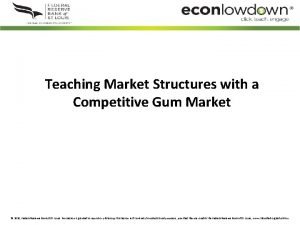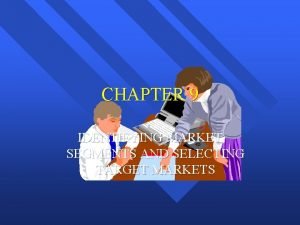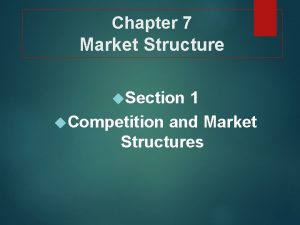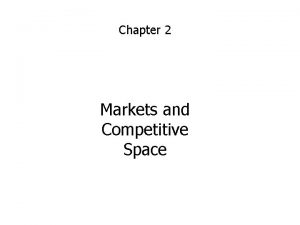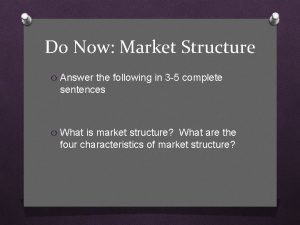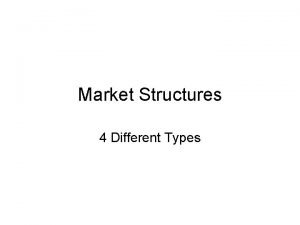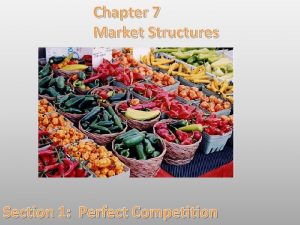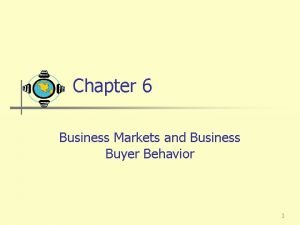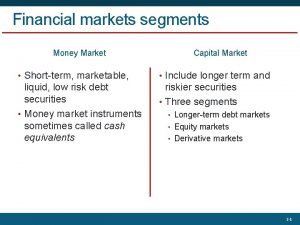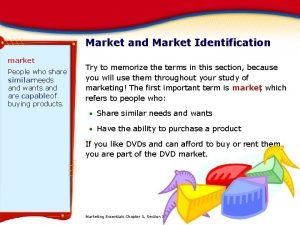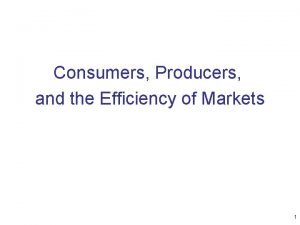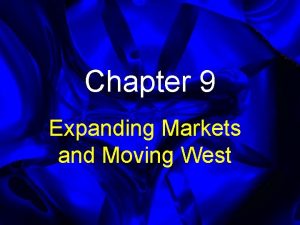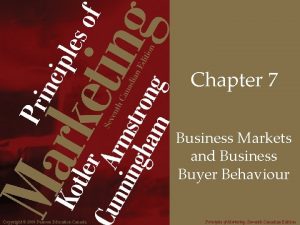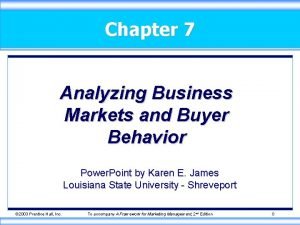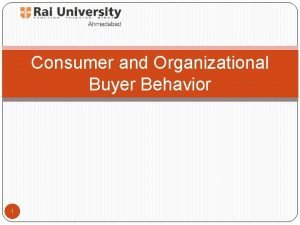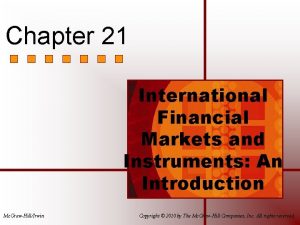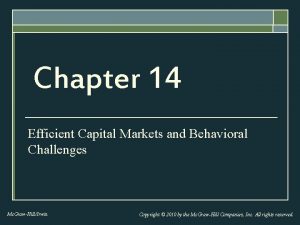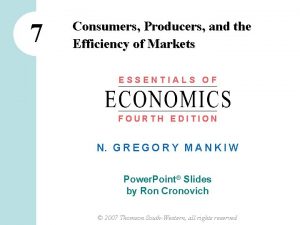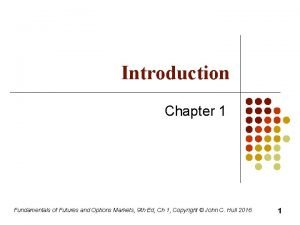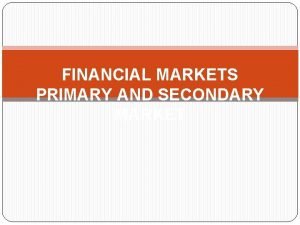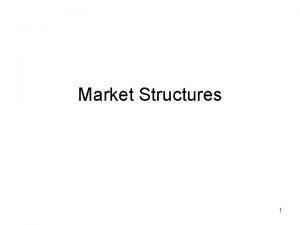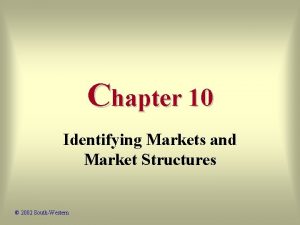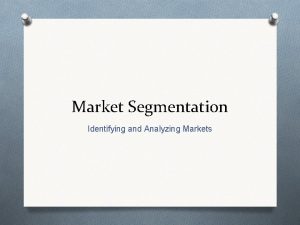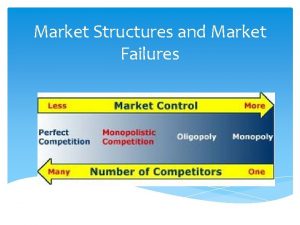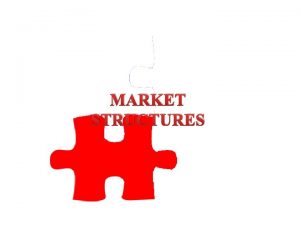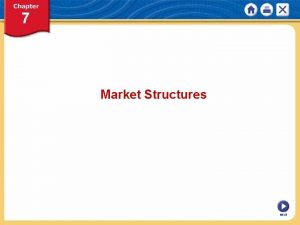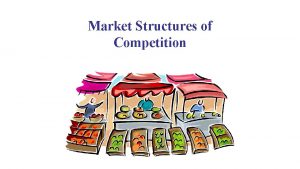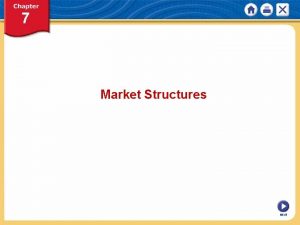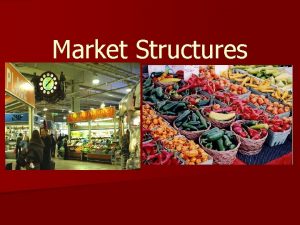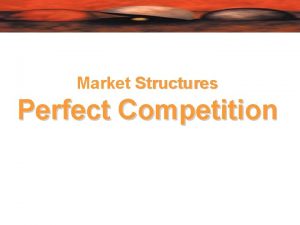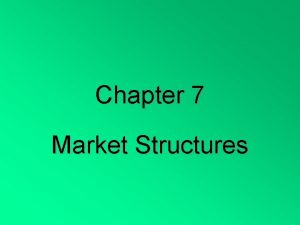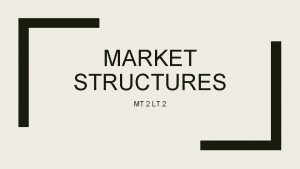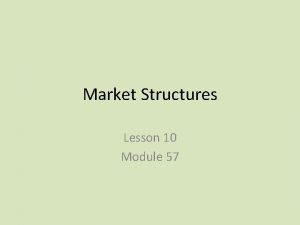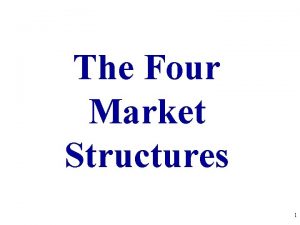Identifying Markets and Market Structures 1024202 1 1




















































- Slides: 52

Identifying Markets and Market Structures 10/24/202 1 1

What is considered an Industry? A collection of firms producing the same good 2

What are the types of markets? Monopoly Oligopoly Perfect Competition 3

What is a Monopoly? A monopoly (mono=one) is when one company takes over all other companies in selling the same product. 4

3 Types of Mergers Economists distinguish between three types of mergers: 1. Horizontal 2. Vertical 3. Conglomerate

A merger is when two or more corporations join to form one new corporation in which only one corporation survives and the merged corporations go out of business. It can be: • voluntary, also known as a ‘merger’ • forced, when it is known as a ‘takeover’ Merger activity is an example of ‘integration’ taking place within industries. This can be: • vertical integration, where firms at different stages in the production chain merge • horizontal integration, where competing firms in the same 6 industry merge

Horizontal mergers A horizontal merger results in the combination of firms that are direct rivals—that is, firms which sell the same products join together. Examples: Boeing-Mc. Donnell Douglas; Staples-Office Depot(unconsummated); Chase Manhattan-Chemical Bank; Southern Pacific RR-Sante Fe RR; Pabst-Blatz; LTVRepublic Steel; Konishiroku Photo-Minolta.

Vertical Mergers The merger of firms that produce different products but rely on each other in the making of that product. Examples: Time Warner-TBS; Disney-ABC Capitol Cities; Cleveland Cliffs Iron-Detroit Steel; Brown Shoe. Kinney, Ford-Bendix.

Multinational corporation A firm which has the power to coordinate and control operations in more than one country, even if it doesn’t own them Horizontal integration: located in different countries to produce the same or similar products. (example: Mc. Donald's) Vertical integration: production in certain country/countries to produce products that serve as input to its production establishments in other country/countries. (example: Adidas or Nike, Inc. ) 9

Vertical integration is characterized by one firm controlling the different aspects of production (e. g. growing raw materials, manufacturing, transporting, marketing, and/or retailing). • A firm owns its suppliers and its buyers. Contrary to horizontal integration, which is a consolidation of many firms that handle the same part of the production process. 10

Carnegie Steel One of the earliest, largest and most famous examples of vertical integration was the Carnegie Steel company. The company controlled not only the mills where the steel was manufactured but also the mines where the iron ore was extracted, the coal mines that supplied the coal, the ships that transported the iron ore and the railroads that transported the coal to the factory, the coke ovens where the coal was coked, etc. The company also focused heavily on developing talent internally from the bottom up, rather than importing it from 11 other companies.

Horizontal integration: • More common than vertical integration. • Eg: A car manufacturer merging with another car manufacturer. In this case both the companies are in the same stage of production and also in the same industry. 12

A conglomerate is a large company that consists of seemingly unrelated businesses http: //en. wikipedia. org/wiki/List_of_conglom erates 13

http: //www. pg. com/en_US/products/all_products/index. shtml http: //www. unilever. com/ourbrands/ http: //www. jnj. com/connect/healthcare-products/ Mom and pop 14

Why Mergers? Firms are sometimes keen to merge when: • they can make savings from being bigger • this is known as gaining ‘economies of scale’ • they can compete with larger firms or eliminate competition • they can spread production over a larger range of products or services 15

Agribusiness includes the production, processing, and supply of agricultural goods. • Not the same as family farming • Typically quite large • Vertical and horizontal integration • Run like a true business, or corporation • Administrators not farmers make business decisions. 16

-highly efficient and streamlined organization allows agribusiness to: - keep food costs low Major criticism: forcing small farms out of business What does this limit in the Free Market? Competition http: //www. agriculture. ilstu. edu/undergraduate/Agribusiness. Companies. shtml

What is an Oligopoly? When a few firms dominate the production of similar goods or a good. • Entry for a new company into the market is difficult - Name an Oligopoly 18

How do Pepsi & Coca-Cola differentiate themselves? 19

What is Brand Loyalty? The willingness of consumers to continue buying a good at a price higher than the price of its close substitutes 20

Perfect Competition • Many companies making similar products with few barriers to entry for new companies. - Leads to lower prices and better quality. 21

Market Number of Control over Type of product firms price Pure Very large competition Competition None Standardized Price-based Oligopoly Few dominant firms Fair amount of control Standardized or differentiated Non-price competition for differentiated products Monopoly One Large One Non-existant 22

What is the Law of Diminishing Returns? • As more units of a resource are added to production output will increase by smaller amounts. 23

If one factor of production is increased while the others remain constant, the marginal benefits will decline and, after a certain point, overall production will also decline. Marginal cost measures the change in cost over the change in quantity. For example, if a company is producing 10 units at $100 total cost, and steps up production to 11 units at $120 total cost, the marginal cost is $20. Basically…If you add more workers, you will experience Diminishing Return 24

Number of Workers Corn Produced Marginal Benefit 1 10 10 2 25 15 3 45 20 4 60 15 5 70 10 6 60 -10 25

Comparative advantage is the ability of a country to produce a good at a lower opportunity cost than another country can. • The United States buys bananas from other countries because it does not have the soil and climate to grow them. • Countries that do not have the factories and skilled workers to make airplanes buy them from the United States. 26

Comparative Advantage • Suppose China were only ½ as productive – now, it has absolute advantage in nothing! • Can it still gain from trade? Yes! It still has comparative advantage. • Comparative advantage = lower opportunity cost Output per hour work Drugs (DR) Clothes (CL) U. S. 8 6 China 3 4 27

Comparative Advantage and Specialization Six hours without Specialization Six hours with Specialization Car washing Lawn mowing n. David 3 1 n. David 6 0 n. Casey 4 3 n. Casey 0 6 7 4 6 6 28

Why Nations Trade (cont. ) • The United States could make color televisions. • However, other countries can make them at a lower cost, so the United States buys many color televisions from these countries. • Comparative advantage leads nations to specialize. • They use their scarce resources to produce those things that they produce better than other countries. 29

Barriers to International Trade • Foreign countries with a comparative advantage can sell their product more cheaply than companies making the product in their own country. • Consumers will likely buy the cheaper foreign product. • Workers who make the product in their own country may lose their jobs as sales drop. • When this happens, the government may impose trade barriers to protect the affected workers and industries. 30

Barriers to International Trade (cont. ) • A tariff is a tax on an imported good. • The goal is to make the price of imported goods higher than the price of the same good produced domestically. • As a result, consumers would be more likely to buy the domestic product. • When people want the product so badly that higher prices have little effect, countries may set quotas, or limits on the amount of foreign goods imported. 31

Consider This “Sweet” Example • In 2000, the sugar lobby contributed $13 million to politicians. • The government restricts sugar imports into the U. S. through quotas. • The average U. S. consumer pays $20 per year in higher sugar prices while sugar growers gain about $1. 9 billion. • IS THIS A SOUND GOVERNMENT PROGRAM? DISCUSS. 32

Barriers to International Trade (cont. ) • Trade barriers force consumers to pay higher prices for the sake of protecting inefficient industries. • In general, trade barriers cost more than the benefits gained. • For this reason, most countries now aim to achieve free trade. • They try to convince countries not to pass laws that block or limit trade. 33

Why the stress on free world trade? • The world economy went into a deep depression in the 1930 s, as many countries closed their barriers to trade with other states. This led to: • Mass unemployment • Social upheaval • Rise of fascism and the Second World War 34

Barriers to International Trade (cont. ) • A recent trend is for countries to join with a few key trading partners to form free trade zones. • The European Union (EU) is an organization of 15 European countries, with no trade barriers and a common currency, the euro. • forms a huge market. • Goods flow freely among these nations. 35

Barriers to International Trade (cont. ) • In the 1990 s, the United States, Canada, and Mexico signed the North American Free Trade Agreement (NAFTA). • This deal eliminated all trade barriers among these countries. • Opponents of NAFTA contended that American workers would lose their jobs because U. S. plants would move to Mexico or other countries. 36

Barriers to International Trade (cont. ) • There the companies could get cheaper labor and less strict enforcement of environmental and workers’ rights laws. • NAFTA supporters argued that increased trade would stimulate growth and put more low-cost goods on the market. 37

Outsourcing in North Carolina’s Furniture Industry

The Facts: Manufacturing lost 31, 100 jobs in 2003 • The decline in several of North Carolina’s traditional manufacturing industries has hurt our economy. • In the last year alone (since 2003), NC lost 5% of its total manufacturing employment, a loss of 31, 000 jobs – in old and new industries • • Textiles – 7, 700 (21. 4%) Furniture – 5, 300 (8. 4%) Apparel – 5, 200 (16. 5%) Computers and Electronics – 3, 500 (8. 3%) 39

Job losses in furniture are real: • 75% of wood and metal furniture sold in the US in 2002 was imported. • Even as firms merged, downsized and shut down, furniture sales rose by 5% in 2003. • Thus, the fortunes of firms and of workers in the industry are diverging 40

The sharpest declines in furniture firms in NC came after 2000, 6 years after NAFTA was passed 41

Thus, the Changes in the NC furniture market were underway well before trade barriers fell • Tight labor market in the 1990 s pushed US firms to recruit skilled woodworkers in Mexico • Changes in the structure of the industry’s supply chain throughout the 1980 s and early 1990 s - rising demand led to growing capacity utilization and even inefficient plants were profitable; • When the cresting demand abated in the recession of the early 1990 s, the lowest margin firms went under. • When tariffs fell, intensifying competition added to the pressure on the bottom line, leading firms to find ways to cut costs. Strategies: – Mergers, – Takeovers – And: a growing number of firms began to turn to China for cheaper imports 42

How are local firms responding? • Consolidating or closing down – Manufacturers getting involved with franchise stores • Outsourcing ever wider segments of their product lines to China • Focusing on the high or low end of the market. – The middle price points are hurting the most – Lowest price points are automating to increase productivity – The highest quality segments are adopting innovative training and human resource practices to retain a versatile and skilled workforce • Segments like upholstered furniture, custom designs are doing quite well – competition with China is mainly in wood products 43

Barriers to International Trade (cont. ) • The World Trade Organization (WTO) oversees trade among nations. • It organizes negotiations about trade rules and helps countries trying to develop their economies. • Critics say that WTO policies favor corporations at the expense of workers, the environment, and poor countries. 44

What does the International Monetary Fund do? IMF: • Lends money to developing countries • Pushes for economic reforms • Reports on policies in member states 45

Terms to know • A trade deficit is a situation in which exports are less than imports. – Imports > Exports • A trade surplus is a situation in which exports are greater than imports. – Exports > Imports • Balanced trade refers to when exports and imports are exactly equal. 46

Figure 1 The Internationalization of the U. S. Economy Percent of GDP 15 Imports 10 Exports 5 0 1955 1960 1965 1970 1975 1980 1985 1990 1995 2000 47 Copyright © 2004 South-Western

Exchange Rates • The exchange rate is the rate at which a person can trade the currency of one country for the currency of another. • The exchange rate is expressed in two ways: – In units of foreign currency per one U. S. dollar. – And in units of U. S. dollars per one unit of the foreign currency. • http: //www. xe. com/ucc/ a internet based currency converter (can’t be used on tests!) 48

What is an example of Government protection? The granting of a patent 49

What is a Patent? A monopoly right to the use of a specific new technology or the production of a new good 50

Why grant Patents? To encourage inventions and innovations © 1999 South-Western College Publishing 51

What is Market Share? The percentage of total market sales produced by a firm in a market © 1999 South-Western College Publishing 52
 Identifying and non identifying adjective clauses
Identifying and non identifying adjective clauses How to identify clauses
How to identify clauses Identify the essential
Identify the essential Teaching market structures with a competitive gum market
Teaching market structures with a competitive gum market Market segmentation market targeting and market positioning
Market segmentation market targeting and market positioning Leader follower challenger nicher
Leader follower challenger nicher Identifying market segments and targets chapter 9
Identifying market segments and targets chapter 9 Identifying market segments and targets chapter 9
Identifying market segments and targets chapter 9 Identifying market segments and targets chapter 9
Identifying market segments and targets chapter 9 Five patterns of target market selection
Five patterns of target market selection Segment by segment invasion
Segment by segment invasion Single segment concentration
Single segment concentration Homologous structures definition
Homologous structures definition Chapter 7 lesson 1 competition and market structures
Chapter 7 lesson 1 competition and market structures Product market boundaries and structures
Product market boundaries and structures Market structures gallery walk
Market structures gallery walk What is pure competition?
What is pure competition? Pure competition vs monopolistic competition venn diagram
Pure competition vs monopolistic competition venn diagram Perfect competion examples
Perfect competion examples Pure competition companies
Pure competition companies Chapter 7 market structures vocabulary
Chapter 7 market structures vocabulary Market structure dominated by a few large profitable firms
Market structure dominated by a few large profitable firms Primary target market and secondary target market
Primary target market and secondary target market Decision making units
Decision making units Bond equivalent yield formula
Bond equivalent yield formula Concept of market and market identification
Concept of market and market identification Document sample
Document sample Short term funds
Short term funds Why study financial institutions
Why study financial institutions Participants in money market
Participants in money market Consumers producers and the efficiency of markets
Consumers producers and the efficiency of markets Historic tax credit structure diagram
Historic tax credit structure diagram Black box model consumer behaviour
Black box model consumer behaviour Chapter 9 expanding markets and moving west
Chapter 9 expanding markets and moving west Business buyer behaviour
Business buyer behaviour Analyzing consumer and business markets
Analyzing consumer and business markets Business markets and business buyer behavior
Business markets and business buyer behavior Financial institutions and markets lecture notes ppt
Financial institutions and markets lecture notes ppt Urban economics and real estate markets
Urban economics and real estate markets Sociology major dartmouth
Sociology major dartmouth Mutual fund flows and performance in rational markets
Mutual fund flows and performance in rational markets The financial system
The financial system Consumer markets and consumer buyer behavior
Consumer markets and consumer buyer behavior Organizational buying behaviour
Organizational buying behaviour Target market and channel design strategy
Target market and channel design strategy Chapter 5 consumer markets and buyer behavior
Chapter 5 consumer markets and buyer behavior International financial markets and instruments
International financial markets and instruments Efficient capital markets and behavioral challenges
Efficient capital markets and behavioral challenges Consumers producers and the efficiency of markets
Consumers producers and the efficiency of markets B f d
B f d Savers and investors role in financial markets
Savers and investors role in financial markets Forward vs option
Forward vs option Difference primary and secondary market
Difference primary and secondary market



